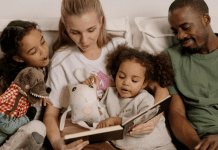
A sensory room is a room that is dedicated to sensory experiences. This means that it’s a room constructed to give your child different sensory inputs than they usually get. It is a space designated to offer your child (or even you!) a plethora of sensory-filled activities for fun, stimulation, and/or relaxation.
Sensory rooms are used to create a calm, safe environment for your child. They can also help develop key life skills like gross motor skills, fine motor skills, vocalization/language skills, tracking/visual perception, and regulation skills.
Sensory Integration Therapy
Sensory rooms come from the practice of Sensory Integration Therapy, where using sensory input is used to help either calm or stimulate your child to help them deal with their stress levels and feeling of well-being. This form of therapy has been around since the 1960s. But it seems like the science is just starting to catch up here in the last decade or so. Research has shown that patients who used the sensory room reported a positive response and a decrease in perceptions of distress.

Here are 10 sensory tools you can use to create a sensory-filled space for your child (or even for you!):
Suspended Equipment
Swinging is one way to stimulate the vestibular system, which processes movement and helps with sensory regulation. Vestibular input is a fancy word for the feeling of swinging. I love the ones that look like little cocoons. I hung my daughter’s swing really low to the ground, so that she can independently get in and out of it and so that it is safe if she were to fall out. You can even combine the swing with the weighted blanket (listed below) to get a really nice calming combination.
Weighted Products
A weighted blanket, lap pad, or weighted vest provides deep touch pressure (DTP) or proprioceptive which has a calming, organizing effect on the child. Occupational therapists often recommend weighted products as part of a comprehensive sensory diet to help children with sensory processing disorders or self-regulation difficulties. My son and I have both been sleeping much better ever since we included weighted blankets in the mix! (Keep in mind that it should be 10% of body weight!)
Compression Tools
Tools that compress, like a weighted compression vest or one that’s made out of lycra (giving them a sense of feeling like they are being hugged). This may be helpful for children who seek out deep pressure and prefer tight-fitting clothes. Compression tools can also provide the benefits of deep touch pressure.
Balance Tools
A balance beam or balance board is a wonderful piece of equipment to help with gross motor skills, balance, and coordination.
Tactile Media
Sensory bins, sand, or water tables, and play dough serve as a space to work on fine motor skills and hand strength. Sequin pillows are also a fun way to provide tactile stimulation that is also calming.
Crash Mat and Trampoline
Jumping or crashing delivers proprioceptive and vestibular input to people of all ages. Keeping the crib mattress is a good idea to offer a crash mat to your littles without spending extra cash!
Alternative Seating
Consider adapted seating which are different seating options that can improve attention by targeting the vestibular system. Adapted seating should not be looked at as a reward for good behavior or as a toy. These are tools to aid in improving regulation and their ability to focus and learn, such as a wobble cushion or chair bands to name a few.
Aromatherapy
A sensory experience that stimulates our olfactory system. An easy way to get the benefit of aromatherapy without the chemicals is to get some essential oils. You can dab a little bit on a light bulb, which will warm the oil and release the scent. If you are looking for calming scents, vanilla, lavender, peppermint, or jasmine are good choices. If you are looking for stimulating scents, cinnamon, floral scents, or spices work well.
Auditory Stimulation
If you have a CD player or white noise machine, this is another easy addition to your sensory room. You can play calming music for your child, such as nature sounds, white noise, or classical music. My son loves his white noise machine. Sometimes, at least for me, silence can sound loud. Having some nice calming music or tones helps me feel calm and regulated.
Tunnel or Tent/Teepee
Setting up a quiet space or a sensory deprivation area is an important part of a sensory room at home for a child with a sensory processing disorder. I love referring to this space as their calm down space or safe space to feel all of their big emotions. I’ve even added an emotional regulation/sensory basket in my daughter’s calm-down space using this adorable canvas house tent. This is truly the most effective time when we, as parents, are able to practice co-regulation and be the calm to their storm.

Please note that these are just general ideas. The items selected should be specific to your sensory profile and sensory diet.
















